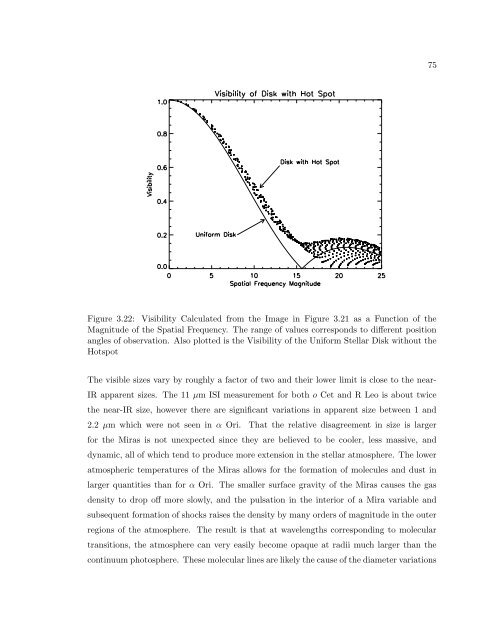The Size, Structure, and Variability of Late-Type Stars Measured ...
The Size, Structure, and Variability of Late-Type Stars Measured ...
The Size, Structure, and Variability of Late-Type Stars Measured ...
Create successful ePaper yourself
Turn your PDF publications into a flip-book with our unique Google optimized e-Paper software.
75<br />
Figure 3.22: Visibility Calculated from the Image in Figure 3.21 as a Function <strong>of</strong> the<br />
Magnitude <strong>of</strong> the Spatial Frequency. <strong>The</strong> range <strong>of</strong> values corresponds to different position<br />
angles <strong>of</strong> observation. Also plotted is the Visibility <strong>of</strong> the Uniform Stellar Disk without the<br />
Hotspot<br />
<strong>The</strong> visible sizes vary by roughly a factor <strong>of</strong> two <strong>and</strong> their lower limit is close to the near-<br />
IR apparent sizes. <strong>The</strong> 11 µm ISI measurement for both o Cet <strong>and</strong> R Leo is about twice<br />
the near-IR size, however there are significant variations in apparent size between 1 <strong>and</strong><br />
2.2 µm which were not seen in α Ori. That the relative disagreement in size is larger<br />
for the Miras is not unexpected since they are believed to be cooler, less massive, <strong>and</strong><br />
dynamic, all <strong>of</strong> which tend to produce more extension in the stellar atmosphere. <strong>The</strong> lower<br />
atmospheric temperatures <strong>of</strong> the Miras allows for the formation <strong>of</strong> molecules <strong>and</strong> dust in<br />
larger quantities than for α Ori. <strong>The</strong> smaller surface gravity <strong>of</strong> the Miras causes the gas<br />
density to drop <strong>of</strong>f more slowly, <strong>and</strong> the pulsation in the interior <strong>of</strong> a Mira variable <strong>and</strong><br />
subsequent formation <strong>of</strong> shocks raises the density by many orders <strong>of</strong> magnitude in the outer<br />
regions <strong>of</strong> the atmosphere. <strong>The</strong> result is that at wavelengths corresponding to molecular<br />
transitions, the atmosphere can very easily become opaque at radii much larger than the<br />
continuum photosphere. <strong>The</strong>se molecular lines are likely the cause <strong>of</strong> the diameter variations













![Problem #1 [Structure Formation I: Radiation Era]](https://img.yumpu.com/37147371/1/190x245/problem-1-structure-formation-i-radiation-era.jpg?quality=85)


